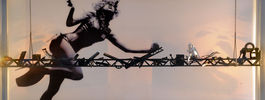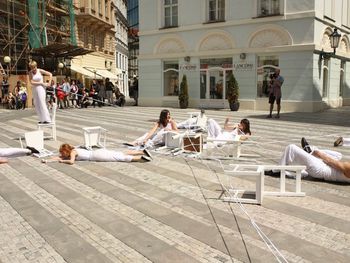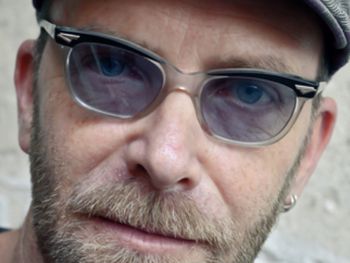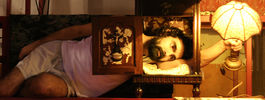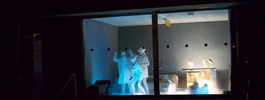Scenarist of the exhibition: Shizuko Sato Katatani
Japanese stage design can be roughly divided into two lines of development.
The first of these, belongs to the traditional Japanese Kabuki drama, which has been handed down from generation to generation. Its beginnings are to be found around the year 1620. Originally, Kabuki plays were presented on a three-sided stage, not too different from the Elizabethan stage of Shakespeare s time. During the XVIIIth and XIXth century the uniform, standard Kabuki stage was completed by incorporating a scene switching device and unique background paintings, which have been handed down to the present time. The setting is based on a rectangular proscenium framework, while the background reminds us of typical Japanese scroll painting.
The second line of development represents modern dramatic and stage designing art, which came to Japan from Europe at the beginning of the XXth century. Such stage sets greatly differ from the stage design of traditional Japanese drama, which has remained untouched by foreign influences. The seventy years which have elapsed since the first presentation of European drama on the Japanese stage can be divided into two distinct periods. The early period between 190O and 1940 was characterized by attempts to imitate European theatrical art. The first Japanese stage sets were designed in 1903 for Orpheus and Euridice and for Othello. In l920 the small Tsukiji Theatre was built, with a Kuppel Horizont. Its beginnings were characterized by various experiments with various styles of direction and stage designing, from the realism of the Moscow Art Theatre, through expressionism according to Max Reinhardt, up to Meyerhold’s constructivism. At the end of the thirties a number of European opera and ballet companies were on toure in Japan. However, the World War II put a forcible end to this period; it had a very strong impact also on the theatre. Only at the end of World War II was a renewal of theatre activity possible. 1945 marks the beginning of the second period, which differs from the first in a basic manner by the increased number of stage forms. Besides drama, also opera, ballet, musical drama, dance, etc. appeared. It should be noted that in spite of the fact that European classical and avant-guarde plays were presented in rapid succession, at the same time a number of new Japanese plays were produced, which drew their material from local customs, habits and legends.
While it is true that the theatre in Japan at present is very active, insufficient government financial support represents a constant threat to the very existence of the majority of theatres, with the exception of those which are purely commercial. For these economic reasons it has, in recent years, become almost impossible for smaller companies to encompass a more broad program of plays. As far as stage designing is concerned, contemporary endeavours have abandoned attempts to form richly decorative or realistic scenery; symbolic objects are making their appearance, making use of projections or simple compositions based on the possibilities provided by new materials. The most recent trend, which places special stress on the costume and properties, is not only dictated by economic pressures, but is above all testimony of the manner in which contemporary demands of drama have been met. Stage designing is undergoing constant development and thus stage designers are forced to seek new methods of expression, to use new materials, equipment and mechanisms.
- Shogoro Motomiya
Additional information: Born in 1927; graduated from Iwate University, at present he is a member of the Stage and Technical Committee of the Modern Theatre Association, full-time lecturer at the Tama Art Institute, a member of the Japanese Institute for Theatre Technology and a member of the J.A.D.C. Committee. Among his most important works are the stage designs for Shakespeare's Richard III and Titus Andronicus. Endeavours to form a unified stage, while stressing its variable elements, are typical for his style. He participated in the Prague Quadrennials 1967 and 1971.
Obrázky z katalogu
Exhibiting works
-
U. Betti: (Goat Island),
0
-
: (Coriolanus),
0
- Setsu Asakura
Additional information: Born in 1922 in Tokyo. Under the influence of her father, who was one of the foremost sculptors in Japan, she began her artistic career as a painter. She now teaches at the Institute of Industrid Design in Kuwazava. Among her most important stage designs are those for productions of Molière' s The Learned Ladies, Brecht´ s Mother Courage and Her Children, Becketť s Waiting for Godot, Sartre' s Dirty Hanods and Y. Fukuda's Where is the Robber Hakamadare? In 1978 she designed the sets for Medea at the Nissei Theatre and for Hamlet at the Teigeki Theatre. In October 1978 she designed the sets and also directed a production of the play by Taeko Tomioko, The Puppet Sisters, which was also played in the USA /in New York, San Francisco, Santa Fe and Dallas/ and which was very favourably received by critics. Among those who played in this production were Kazuko Yoshiyuki, Nobuko Miyamoto and Magosaburo Yuki. She is a member of JASTA, of ITI and OISTT. She participated in the Prague Quadrennial in 1971 and in 1975.
Obrázky z katalogu
Exhibiting works
-
Williame Shakespeare: (King Lear),
Nissei Theatre
1975, Director: Yukio Ninagawa,
-
: (Gobancho Yugiriro),
Toyoko Theatre
1975
-
Williame Shakespeare: (Romeo and Juliet),
Nissei Theatre
1974
-
Seneca: (Medea),
Kinokuniya Hall
1975
- Shinji Itasaka
* 1929, Wakayama
Specialization: set designer
Additional information: He graduated from Kyoto University, currently teaches stage art in Osaka University.
He has been working predominantly for the New Drama Theatre and for the Theatre of Traditional Dance.
He is at work as designer of the Yomiuri Broadcasting. His artistic creation can be characterized as neorealistic. To his most important works belong sets to original dances and modern dramatic creation. He is a member of the Japan Stage and Television Artists Association.
In 1971, 1975, 1983, 1987, 1991 and 1995 he participated in the PQ.
Exhibiting works
-
Kiyoshi Tsuchiya: (The River),
Ósaka Yubin Hall
1975, Director: Tetsu Komatsu,
-
Seiji Hoki: (Modern Dance),
Ósaka Sankei Hall
1974, Director: Seiji Hoki,
-
Yutaka Shoji: (Mumyo Genji),
Ashiya Runa Hall
1975, Director: Yutaka Shoji,
-
: (Avalanche),
Bunka Seijutsu Hall
1974, Director: Kaoru Fukisawa,
- Kaoru Kanamori
Additional information: Ex-Director of the Nissei Theatre, Deputy of the Kanamori Corporation. His most important works are the designs to Cyrano de Bergerac (1964), Undine (1965), The Devil and the Good God (1965), Andromache (1966), The Lark (1967), King Lear (1967) and The Trojan War Will Not Take Place (1969). He is Director of the Japan Stage and Television Artists Association and a member of the SHIKI Troupe, the Contemporary Theatre Association and the Japanese Institute for Theatre Technology.
Exhibiting works
-
: (Kinzo the Painter),
National Theatre
1972
-
: (As You Like It),
Nissei Theatre
1974
-
A. Lloyd Webber: (Jesus Christ Superstar),
Sun Plaza Hall
1973, Director: Keita Asari,
-
Giacomo Puccini: (Madame Butterfly),
Ósaka Koseinenkin Hall
1974, Director: Reiji Mitani,
-
: (Luminous Moss),
Nissei Theatre Tokyo
1973
-
: (Moment by moment),
Actor's Tehatre Tokyo
1971
- Shigeo Kawamori
Additional information: Graduated from the Faculty of Aesthetics at the Imperial University. He is at work in the Costume Department of Haiyuza. His most important works are the designs of theatre costumes to Hamlet, to The Treepenny Opera and to The Marriage of Figaro. He is a member of the Japan Stage and Television Artists Association.
Obrázky z katalogu
Exhibiting works
-
Maxim Gorkij: (The Lower Depths),
Toyoko Theatre
1975, Director: Toshikiyo Masumi,
-
Chikao Tanaka: (A Train Named Time),
Haiyu-za Theatre
1975, Director: Chikao Tanaka,
- Takehisa Magofuku
Additional information: Graduated from the Tokyo Industrial College. He was at work at the Japan Broadcasting Corporation (NHK). At present he acts as free-lance stage designer. His most important designs are the stage sets to the plays We Are Not an Angel and The Stork. The characteristic feature of his works is an expressive realism of his stage settings.
Exhibiting works
-
Hisashi Inoue: (Bun and Fun After That),
Theatre Echo
1975, Director: Kazuo Kumakura,
-
: (Illusion of Family Reunion),
Togei Gekijo
1975
-
Minoru Betsuyaku: (Yellow Sunday),
Theatre Green
1975, Director: Shinichi Segawa,
- Kotaro Maki
Additional information: Born in 1909 in the prefecture of Ibaragi. After graduation at the Academy of Fine Arts in 1934, where he studied mainly painting, he began to work as a designer. At present he works for the largest Japanese film and theatre company Toho as chief costume designer. Among his most important work, especially after World War II, are the costumes he designed for the Japanese productions of Broadway musicals, including Fiddler on the Roof. He is a member of the Association of Stage and Television Artists and of OISTT. He participated in the Prague Quadrennial in Prague in 1971.
Exhibiting works
-
Williame Shakespeare: (A Midsummer Night's Dream),
Tokyo Imperial Theatre
1975, Director: John David,
- Hachiro Nakajima
Additional information: Born in 1923 in Tokyo. Since 1946 he has been working as a stage designer at the Tokyo Stage Design Workshop Kisaku Ito. He designs sets for traditional Japanese theatres, including the Kabuki theatre. He participated in the PQ in 1971, 1975, 1979 and in 1983.
Exhibiting works
-
: (Temple of Wild Geese),
Nissei Theatre
1972
-
: (Song of a Clown),
Imperial Theatre
1974
-
: (Far Away Is My Town),
Nissei Theatre
1974
-
: (Story of the Castle Keep),
Toyoko Theatre
1974
-
: (Age of Typhoons),
Kabukiza
1975
-
Williame Shakespeare: (A Midsummer Night's Dream),
Imperial Theatre
1975, Director: John David,
-
: (I am Tenichibo),
Meijiza
1975
- Kyoko Nishimura
Additional information: Born in 1931; after graduating from the Kyoto City College of Fine Arts in 1955 she became a member of the design department of the Yomiuri TV Broadcasting Company. Her most important oostume designs were made for Shakespeare's A Merchant of Venice, Ibsen's Hedda Gabler and Takeo Taguchi's Kenjo Katagi /The Way of a Clever Wife/. She has designed costumes for modern ballet, where she endeavours to accomodate traditional Japanese dress
to dancing, while at the same time modernizing it. She is a member of the Association of Stage and Television Artists and of OISTT. She participated in the Prague Quadrennial in 1971.
Exhibiting works
-
Seiji Hoki: (modern dance),
Ósaka Sankei Hall
1974, Director: Seiji Hoki,
- Otoya Oda
Additional information: Born in 1920 in Tokyo; in 1941 he graduated from the Tokyo Art Academy. He began to work as a stage designer in 1947. He has obtained the Mainichi Theatrical Prize and the Ito Kisaku Prize. He is a member of the Association of Stage and Television Artists and of OISTT. A stress on historical detail, which arguments the value of traditional themes is typical for his stage designs. He has designed stage decorations for Kabuki plays, for classical Japanese drama and for Western type plays. He participated in the Prague Quadrennial in 1971.
- Eiji Tahara
Additional information: Born in 1941; he graduated from the Musashino Art University. At present he is chief of stage design of the Japanese Television Networks Company, a member of the Japanese Institute for Theatre Technology and a member of the J.A.D.C. Committee. His most important work are stage designs for Shakespeare's Richard III. Endeavours to form symbolic decorations are typical for his work. He participated in the Prague Quadrennial in 1971.
Obrázky z katalogu
Exhibiting works
- Tatsuo ICHIJO
Additional information: Born in 1924, graduated from the Technical School at Yasuda.Is a member of the Japanese Association of Stage and Television Artists and OISTT.
Obrázky z katalogu
Exhibiting works
-
: (Carrots),
Sabo Kaikan
1971
-
: (In the Shadow of the Glen),
Kinokuniya Hall
1972
-
: (A Memory of Two Mondays),
Sabo Kaikan
1973
-
: (Open the Gate),
Kinokuniya Hall
1973
-
: (Episode),
Sabo Kaikan
1971
-
: (Nomugi Pass),
Sabo Kaikan
1971
- Kumaji KUGIMACHI
Additional information: Born in 1906. He specializes in stage designs for classical Kabuki plays. He is a member of the Association of Stage and Television Artists.
Obrázky z katalogu
Exhibiting works
-
Mokuami Kawatake: (Mekura Nagaya Umega Kagatobi),
National Theatre
1975
- Kappa Senoh
* 1930, Hyogo
Specialization: set designer
Additional information: He exhibited at PQ in 1975, 1991, 1995.
Obrázky z katalogu
Exhibiting works
-
R. Leoncavallo: (I Pagliacci),
Tokyo Bunka Kaikan
1975, Director: Masayoshi Kuriyama,
- Senkichi UCHIYAMA
Additional information: Born in 1929. Stage designer. He has been working predominantly at
the Dance and Drama Theatre in Nagoya. He participated in the PQ in
1983.
Obrázky z katalogu
Exhibiting works
-
Minoru Nishizawa: (Perplexity about 20th Century),
Aichi Prefecture Bunka Kaikan
1972, Director: Kazuya Shimada,
-
Kiichi Ohhashi: (Lovers on the Milky Way Railroad),
Aichi Prefecture Bunka Kaikan
1974, Director: Hajime Ura,
-
: (Mass),
Nagoya Shimin Kaikan Large Hall
1975
-
Sumako Fukao, Yasuko Nakajima: (Woman Who Plays the Flute),
Nagoya Shimin Kaikan Medium Hall
1975, Director: Yosei Yamaji - choreographer,
- Šigeo Okajima
* 1927, Tokyo
Specialization: set designer
Additional information: Set designer, collaborating with Tokyo Engeki Ensemble. He participated in PQ 1983, 1987, 1991.
Exhibiting works
-
Shunsuke Katsuyama: (Blue Was the Sea of Kazanashi),
Haiyu-za Theatre
1973, Director: Masami Uriu,
-
Tomoyashi Murayama: (The Miserables),
Toshi Centre Hall
1973, Director: Tomoyashi Murayama,
-
Mario Flatti-Haruhiko: (Cybele's Sunday),
Haiyu-za Theatre
1975, Director: Shunichi Nakamura,
-
: (Crab Cannery Ship),
Yomiuri Hall
1975


